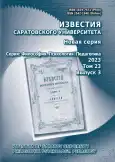Strategies of psychological influence of online groomer on the minor victim in the situation of online sexual harassment
- 作者: Kiselev K.A.1
-
隶属关系:
- Saratov State University
- 期: 卷 23, 编号 3 (2023)
- 页面: 313-317
- 栏目: Articles
- URL: https://journals.rcsi.science/1819-7671/article/view/250995
- DOI: https://doi.org/10.18500/1819-7671-2023-23-3-313-317
- EDN: https://elibrary.ru/RTVEHK
- ID: 250995
如何引用文章
全文:
详细
参考
- Число случаев сексуального насилия в отношении детей в России выросло на 44% с 2010 года. URL: tass.ru/proisshestviya/16661015 (дата обращения: 05.05.2023).
- Алиева Е. А. Сеть Интернет как средство совершения развратных действий // Пробелы в российском законодательстве. 2017. № 4. С. 180–182.
- Медведева А. С. Реакции детей и подростков на сексуальный онлайн груминг // Психология и право. 2020. Т. 10, № 1. С. 123–132. https://doi.org/10.17759/psylaw.2020100111
- Романова Н. М. Представления студентов о рисках вовлечения личности в криминальную деятельность: фокус-групповое исследование // Известия Саратовского университета. Новая серия. Серия: Философия. Психология. Педагогика. 2018. Т. 18, вып. 4. С. 439–444. https://doi.org/10.18500/1819-7671-2018-18-4-439-444
- Аксеновская Л. Н., Прозоров В. В. Взаимосоответствие базовых структур литературных родов и социального взаимодействия в контексте ордерного подхода к социально-психологическому изучению // Известия Саратовского университета. Новая серия. Серия: Философия. Психология. Педагогика. 2016. Т. 16, вып. 2. С. 176–181. https://doi.org/10.18500/1819-7671-2016-16-2-176-181
- Barak A. Sexual harassment on the Internet // Social Science Computer Review. 2005. Vol. 23. P. 77–92. https://doi.org/10.1177/0894439304271540
- Дозорцева Е. Г., Медведева А. С. Сексуальный онлайн груминг как объект психологического исследования // Психология и право. 2019. Т. 9, № 2. С. 250–263. https://doi.org/10.17759/psylaw.2019090217
- Секераж Т. Н. О терминах и понятиях, отражающих явления интернет-коммуникации по делам о нарушении половой неприкосновенности несовершеннолетних // Теория и практика судебной экспертизы. 2022. Т. 17, № 1. С. 130–136. https://doi.org/10.30764/1819-2785-2022-1-130-136
- Нуцкова Е. В., Бадмаева В. Д. Последствия сексуального насилия и злоупотребления в отношении несовершеннолетних: гендерная специфика // Психология и право. 2020. Т. 10, № 3. С. 235–247. https://doi.org/10.17759/psylaw.2020100316
- Scarduzio J. A., Sheff S. E., Smith M. Coping and Sexual Harassment: How Victims Cope across Multiple Settings // Arch Sex Behav. 2018. Vol. 47. P. 327–340. https://doi.org/10.1007/s10508-017-1065-7
- Casanovas L. V.-L., Serra L., Canals C. S. Sanz-Barbero B., Vives-Cases C., Lopez M. J., Otero-Garcia L., Perez G., Renart-Vicens G. Prevalence of sexual harassment among young Spaniards before, during, and after the COVID-19 lockdown period in Spain // BMC Public Health. 2022. Vol. 22. Article number 1822. URL: https://bmcpublichealth.biomedcentral.com/articles/10.1186/s12889-022-14264-9 (accessed 1 May 2023). https://doi.org/10.1186/s12889-022-14264-9
- Gamez-Guadix M., De Santisteban P., Resett S. Sexting among Spanish adolescents: Prevalence and personality profiles // Psicothema. 2017. Vol. 29, iss. 1. P. 29–34. https://doi.org/10.7334/psicothema2016.222
- Кабаченко Т. С. Методы психологического воздействия: учебн. пособие. М. : Педагогическое общество России, 2000. 544 с.
- Кондратьев М. Ю., Ильин В. А. Азбука социального психолога-практика. М. : ПЕР СЭ, 2007. 464 с.
- Kloess J. A., Seymour-Smith S., Hamilton-Giachritsis C. E., Long M. L., Shipley D., Beech A. R. A Qualitative Analysis of Offenders’ Modus Operandi in Sexually Exploitative Interactions With Children Online // Sex Abuse. 2017. Vol. 29, iss. 6. P. 563–591. https://doi.org/10.1177/1079063215612442
补充文件









